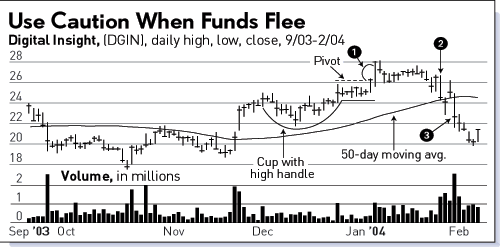
INVESTOR'S BUSINESS DAILY
Successful investors shadow the moves of deep-pocketed institutions. When these big players grab shares of a stock, you should too.
Likewise, when funds start selling hard, it's time to eyeball the exit. The Accumulation/Distribution Rating can help you get a sense if funds no longer demand a stock.
The A/D Rating measures 13 weeks of buying and selling by mutual funds and other big institutions. The best stocks tend to boast an A/D of A or B as they break out of bases and build their uptrends.
A quick drop in the A/D Rating might mean mutual funds are taking profits or casting their eyes elsewhere. An A/D of C indicates roughly equal amounts of buying and selling by the big boys. If the A/D suddenly falls to this level from an A or B, watch for key sell signals.
Don't use the A/D Rating alone as a sell signal, since it can be a lagging indicator. Since it covers the past 13 weeks, the stock may be well off its highs — or even below its pivot — by the time the A/D sinks to a D or E.
Instead, use changes in the A/D to confirm other sell signals such as high-volume declines and broken support lines. The cardinal sell rule remains: Exit a stock if it falls 7%-8% from your purchase price, no questions asked. It doesn't matter if the stock's A/D is an A or a B.
Digital Insight (DGIN) vaulted out of a four-month base on Jan. 5-6 1 . The banking software firm boasted an A/D Rating of A- at its breakout. The stock gained 8% in two days, but struggled to make headway.

Digital's A/D Rating fell from B+ to C+ on Jan. 27 2 as the stock skidded 7.4%. It slumped to C- the next day as the stock closed below its 50-day moving average. On Jan. 30, the A/D fell to D+ as Digital closed 13% below its pivot of 25.94 3 . The 7%-8% sell rule would have forced you out sooner, but the A/D's rapid fall drove the lesson home.
Quality Systems (QSII) broke out of a 10-week base on Jan. 9 and ran up 28% in just two weeks. The health care IT software provider had an A/D Rating of A at its peak. The grade began slipping as the stock declined. But by the time it dipped to C, Quality was nearly back to its pivot. You'd have wanted to sell sooner to preserve your profit.
Amazon.com (AMZN) tried to break out in late January, then saw its A/D Rating decline from B to C on Jan. 28. The more immediate sell signal was a Jan. 28 gap down on huge volume. Price-and-volume action remains your primary selling tool.